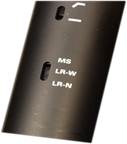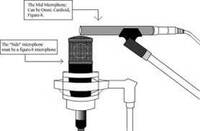 Mid Side stereo recording can be scarey if you spend too much time reading a lot of high tech articles. But as Audio Technica and sound mixer Robert Bigelow (music mixer for HBO’s Treme) demonstrated at the 2012 NAB Show, it is actually a whole lot simpler and easier than you think to record stereo tracks in the field that can be varied during the stages of post production.
Mid Side stereo recording can be scarey if you spend too much time reading a lot of high tech articles. But as Audio Technica and sound mixer Robert Bigelow (music mixer for HBO’s Treme) demonstrated at the 2012 NAB Show, it is actually a whole lot simpler and easier than you think to record stereo tracks in the field that can be varied during the stages of post production.
I wish to enthusiastically thank and give credit to Steve Savanyu who is the Educational Director of Audio Technica; and also my esteemed colleague, Robert Bigelow, for their major contributions to this article. Maybe that is just another way of spelling plagiarism, but my role in this instance is as much as an editor than an author. Many of the words to follow are theirs, and I stake no literary claims to them! But I have added some of my own stuff, as well, so the byline belongs to all three of us.
So just what is Mid-Side Recording?
 Mid-side recording is a technique that offers variable directivity, focus and spatial width of a recorded source.
Mid-side recording is a technique that offers variable directivity, focus and spatial width of a recorded source.
In other words, what you actually record in the field is NOT stereo, but two monaural tracks: one facing the center, and the other one turned 90 degrees to the sides. Later on, during post production, when the center track and the side tracks are mixed together – the result is a mathematically created “stereo” field. The really cool thing is that you can vary the width of the stereo field by changing the proportion of the faders mix in the studio.
Mid-side offers the greatest control over the stereo image in post production. You can control the amount of direct sound from the mid mic and the ambient sound from the side mic offering exceptional control over the stereo field width. With normal (X-Y) stereo recording techniques, you are stuck with what was recorded. With M-S recording, ambient space can be adjusted to the perceived on screen image.
The stereo result that you produce can range from nearly straight-on monaural to narrow wing stereo, or any measure of wide wing stereo you desire. Imagine making angel wings in the snow, except that we are talking about “stereo” wings.
Mid-Side stereo is totally mono compatible. With the left and right signals combined, the summed output is solely from the mid pickup mic. Because of its ability to be folded into a perfect mono signal, it is the ideal technique for stereo recording that may eventually be broadcast in mono.
However, there is a dark side to this technology. Be very careful lest it be taken over by zombies! Very funny, you say. But I am actually quite serious; and this is why I rarely turn over M-S stereo tracks to my clients, unless they are bona fide sound editors and the files are going to them directly (not via some in-house interpretation of file/project volley ball).
If the folks at the other end of your dailies do not fully understand how M-S works, there is almost a certainty that your client will preview the most awful excuse for stereo audio that zombies can cook up! Good M-S does not happen during production sound recording; it is created later during the post phases. Until it reaches the final stereo mixdown, the slightest transfer errors have the potential of ruining the original phasing of the raw tracks – and that would be audio disaster!
So you really have to be careful about who you entrust with raw M-S tracks, because you may be entrusting them with your audio career! At least in terms of that client.
Lots of the time, to be honest, I just switch my single unit M-S shotgun mics over to the wide X-Y setting, and lay down conventional left and right audio tracks. That is one of the niceties of those mics: you can slide a switch to output either raw M-S, narrow left/right, or wide left/right.
But when M-S is handled correctly, it is utterly amazing. Full side to side stereo can just blossom at the touch of a fader, or quietly retreat into crisp, front-on monaural as needed. Multiple versions of the final mix can be mono, stereo, or surround – without fear of phase cancellation wiping out the center track.
Fortunately for us, the industry is becoming more sophisticated when it comes to handling stereo and surround tracks, so the use of M-S tracks is on the rise. But there are still a lot of zombies out there, so make sure to vet out your clients.
If you are doing both the location sound recording, as well as the post production audio – then you definitely have nothing to fear and everything to gain by going with Mid-Side stereo!
Applications for M-S recording include Documentary, Ambient and background recording, Interviews, Live music recording (just watch and listen to Treme!), Wide-angle establishing shots, and Special effects.
However, M-S is not suited for multi angle feature style shooting. For those multi-camera (look at how much time we can save, lol), it is best to stick with conventional monaural dialogue techniques. But that is a whole new article in itself.
Let’s look at how M-S recording works.
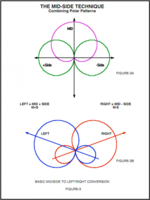 Mid-side recording techniques use two microphones (a monaural or shotgun mic, along with a figure 8 music mic), or one of the new M-S stereo (single unit) microphones such as the Audio Technica BP2029 and BP2027 stereo shotguns.
Mid-side recording techniques use two microphones (a monaural or shotgun mic, along with a figure 8 music mic), or one of the new M-S stereo (single unit) microphones such as the Audio Technica BP2029 and BP2027 stereo shotguns.
Note: other companies besides Audio Technica also make M-S stereo mics, but since they did not contribute content to this article, nor put on free lectures during NAB, I am not going to give them a promotional plug!
And bet you didn’t know that all of the venue sound effects at the London Olympics were recorded with Audio Technica mics. Literally hundreds and hundreds of mics, all rigged by Dennis Baxter and his crew.
The Mid (middle or center channel) is typically a cardioid capsule. However, anything from dynamic mics to hyper-cardioid can be used. The center mic is a directional mono and is pointed at the center of the sound source.
The side consists of a figure eight condenser. The figure eight is arranged so that it is aligned in the cardioid mic’s vertical axis as close to the cardioid mic as possible.
The figure 8 is pointed 90 degrees away from the cardioid mic with the positive (+) normal phase side of the capsule facing stage left (this is important) and the negative (-) reverse phase side facing stage right.
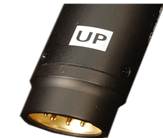 If you were to look down at the single unit M-S shotgun mic or figure 8 mic (with the XLR connector or back of the mic towards you, and the head of the mic aimed away from you, and the words THIS SIDE UP on the mic looking up at the sky) -- then the positive side would be on your right, and the negative side would be on your left. When you are miking from the audience side of the stage, what you are looking at is STAGE LEFT (performer’s left) on YOUR RIGHT (audience right); and STAGE RIGHT is on your left.
If you were to look down at the single unit M-S shotgun mic or figure 8 mic (with the XLR connector or back of the mic towards you, and the head of the mic aimed away from you, and the words THIS SIDE UP on the mic looking up at the sky) -- then the positive side would be on your right, and the negative side would be on your left. When you are miking from the audience side of the stage, what you are looking at is STAGE LEFT (performer’s left) on YOUR RIGHT (audience right); and STAGE RIGHT is on your left.
Make sure that the plus side of the mic is facing stage left (which is audience right). It is important that the capsules of the two mics align on the same vertical axis as this technique depends upon the signals being phase aligned.
When you are recording on location in the field, you will record two discreet tracks. One track will consist of the “mid” or center audio, and is captured using a monaural cardioid, short shotgun, or long shotgun. The second track will be the “side” track, which is recorded with a figure 8 (still a monaural signal) that is positioned perpendicular to the center mic. The figure 8 mic is capturing the left and right ambience.
Monitoring the M-S raw tracks is difficult, since the tracks have not been decoded yet. Some mixing panels offer the option of a decoded M-S headphone monitor, but many sound mixers find that the resulting temp mix is too compromised and confusing. Instead, experts such as Robert Bigelow suggest that after checking both mics individually in the headphones, it is better to only monitor the center mic during the actual session. Remember that the center or mid mic will become the basis of your monaural mixdown, and pretty much represents the spine of your stereo mixes. As long as you have determined that the figure 8 is working and positioned correctly, there is no need to listen to it during the live recording.
The process during Post-Production works as follows.
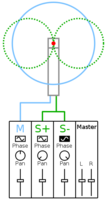 Import the tracks into a Digital Audio Workstation. Although ProTools is the standard, you can create M-S with free programs such as Audacity.
Import the tracks into a Digital Audio Workstation. Although ProTools is the standard, you can create M-S with free programs such as Audacity.
The center or mid channel is left untouched, and exists as a monaural track.
Make a copy of the side track. The side channel track is cloned, so there are now two identical side tracks.
Using an inversion plug-in or from a dropdown menu, reverse the polarity (invert) the side track copy. Thus, the newly created copy of the side channel is phase inverted.
Highlight the two side channel tracks, and link them as a stereo pair. Or, group the side tracks into a left and right stereo track. The original side is panned hard left, and the phase inverted side is panned hard right.
Now, there are three discreet channels: mid, original side, and phase inverted side. Utilizing these three channels, post sound mixers can adjust the stereo field by increasing the levels of the side channels or fold all three channels into a true mono channel with no phasing artifacts. Adjust the level of the left and right stereo pair relative to the center track in order to create your stereo image.
You can add more side tracks to increase width to your mix, or less to draw focus to the recorded source.
Points to remember.
You need to carefully select your mic position relative to the performance (and your screen audience). If you are using two microphones, pay close attention to how you rig the figure 8 component. Make sure that the mic is rotated properly so that the plus side is on the audience right (stage performers’ left).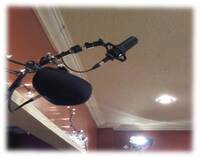
If you are using a single unit M-S mic, then make sure that the label “This Side Up” is facing the sky to insure that the plus and negative sides of correctly oriented.
Note that you can also record rear surround tracks, by adding a second M-S stereo single unit mic facing to the rear (assuming that there is something to your rear that is worth recording!). For the rear facing mic, you want the label “This Side Up” to be rotated DOWN, in order to maintain consistency and thus keeping the plus side remaining on the audience right (stage performers’ left). In other words, you must make sure that the plus sides of both the front-surround and the rear-surround M-S mics remain on the same side.
Distance is not your friend. Try to rig your stereo mic relatively close to the source, in order to get crisp and clean tracks.
Unless directly specified by the production company, you should record discreet mid and side channels without applying any recording device’s internal decoders. Save all of the decoding for post production.
Have fun and experiment. M-S is really not that scarey nor hard to do, especially with the large selection of single unit M-S shotgun mics available.

